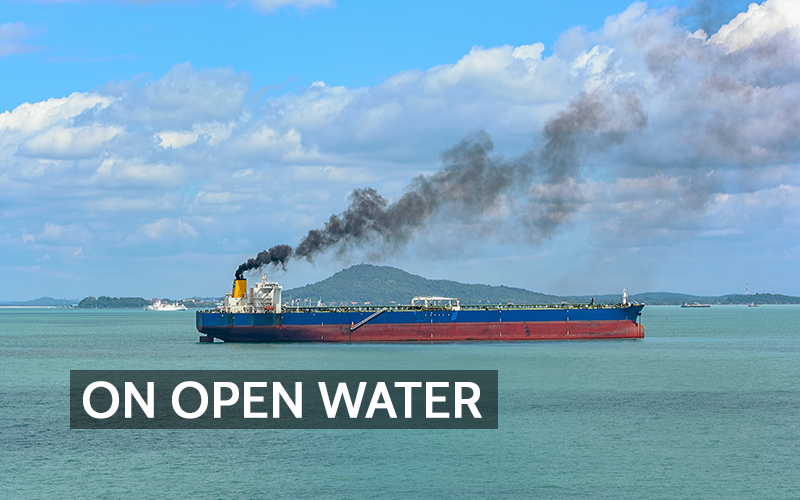Shipping is the lifeblood of global trade, with over 80% of the world’s goods transported by sea. However, this industry is also a major contributor to air pollution, significantly impacting the environment and human health. This article delves into why ships pollute so heavily, who oversees pollution in international waters, and the steps being taken to address this pressing issue.
Why do Ship Produce a lot of Pollution?
Commercial ships, especially large cargo vessels, rely heavily on heavy fuel oil (HFO), a low-quality byproduct of crude oil refining. HFO is one of the dirtiest fossil fuels, containing high levels of sulfur, heavy metals, and other pollutants. When burned, it releases harmful emissions, including sulfur oxides (SOx), nitrogen oxides (NOx), carbon dioxide (CO2), and particulate matter (PM).
These emissions contribute to several environmental issues:
- Global warming: The shipping industry accounts for nearly 3% of global CO2 emissions, a figure comparable to the annual emissions of entire developed countries.
- Acid rain: SOx and NOx emissions react with water vapor in the atmosphere to form acids, which fall to the ground as acid rain, damaging ecosystems and infrastructure.
- Air quality degradation: Fine particulate matter and NOx exacerbate respiratory and cardiovascular diseases, posing severe health risks for coastal and port communities.
The sheer scale of global shipping amplifies these effects. For instance, some of the busiest shipping lanes—such as the Strait of Malacca, the English Channel, and the Panama Canal—are hotspots for concentrated emissions.
Who Monitors Pollution in International Waters?
Regulating pollution in international waters is a complex challenge due to the lack of a centralized governing body. However, several organizations and agreements work to address this issue:
- The International Maritime Organization (IMO): The IMO, a United Nations agency, is the primary entity responsible for regulating shipping emissions. Its most significant measure is the International Convention for the Prevention of Pollution from Ships (MARPOL), specifically Annex VI, which sets limits on SOx, NOx, and particulate emissions.In 2020, the IMO implemented a global sulfur cap, reducing the allowable sulfur content in marine fuels from 3.5% to 0.5%. This landmark regulation aims to cut SOx emissions by 77%, preventing millions of premature deaths and reducing environmental damage.
- Regional initiatives: In addition to IMO regulations, some regions have established Emission Control Areas (ECAs), where stricter emission standards apply. Notable ECAs include the Baltic Sea, the North Sea, and parts of North America.
- Port authorities and national governments: Local authorities also play a role by monitoring emissions and incentivizing cleaner practices. For example, the Port of Los Angeles offers discounts to vessels using cleaner fuels or shore power while docked.
Despite these efforts, enforcement remains a challenge, particularly in open oceans far from regulatory oversight.
Steps Toward Cleaner Shipping
While the shipping industry’s environmental footprint is substantial, several initiatives aim to mitigate its impact:
- Transitioning to cleaner fuels: The shift from HFO to cleaner alternatives like liquefied natural gas (LNG), biofuels, and methanol is gaining traction. These fuels produce fewer emissions, though they are not entirely carbon-neutral.
- Adopting innovative technologies: Advances in ship design and propulsion systems are helping reduce emissions. For example, air lubrication systems minimize friction between the hull and water, improving fuel efficiency. Additionally, wind-assisted technologies, such as sails and rotor sails, are making a comeback, especially for bulk carriers.
- Electrification and renewable energy: Battery-powered ferries and hybrid vessels are emerging as viable options for short-distance routes. Solar panels and hydrogen fuel cells are also being explored to power auxiliary systems or supplement main engines.
- Carbon pricing and market-based measures: Several stakeholders advocate for carbon pricing to incentivize greener practices. The European Union, for instance, plans to include shipping in its Emissions Trading System (ETS), compelling ship operators to pay for their carbon emissions.
- Collaboration and research: Industry stakeholders are forming alliances to develop sustainable solutions. For example, the Global Maritime Forum’s “Getting to Zero Coalition” aims to deploy commercially viable zero-emission vessels by 2030.
On the Horizon
The shipping industry’s transition to sustainability is fraught with challenges. Cleaner fuels and technologies often entail higher costs, which can deter adoption in a highly competitive market. Moreover, regulatory enforcement in international waters remains inconsistent, undermining global efforts.
Nonetheless, the urgency to act is clear. The impacts of shipping emissions extend beyond immediate environmental and health concerns, contributing to the broader climate crisis. Strengthened regulations, technological innovation, and international collaboration will be critical to charting a cleaner course for global shipping.
By prioritizing sustainable practices and embracing innovation, the industry can balance its pivotal role in global trade with its responsibility to the planet.
Related Article:
Emissions to Efficiency: Regulating Air Quality in Paper Production
References:
- https://www.unctad.org
- https://www.epa.gov
- https://www.ipcc.ch
- https://www.imo.org
- https://www.transportenvironment.org
- https://www.portoflosangeles.org
- https://www.dnv.com
- https://www.windshiptechnology.com
- https://www.motorship.com
- https://www.europarl.europa.eu
- https://www.globalmaritimeforum.org


